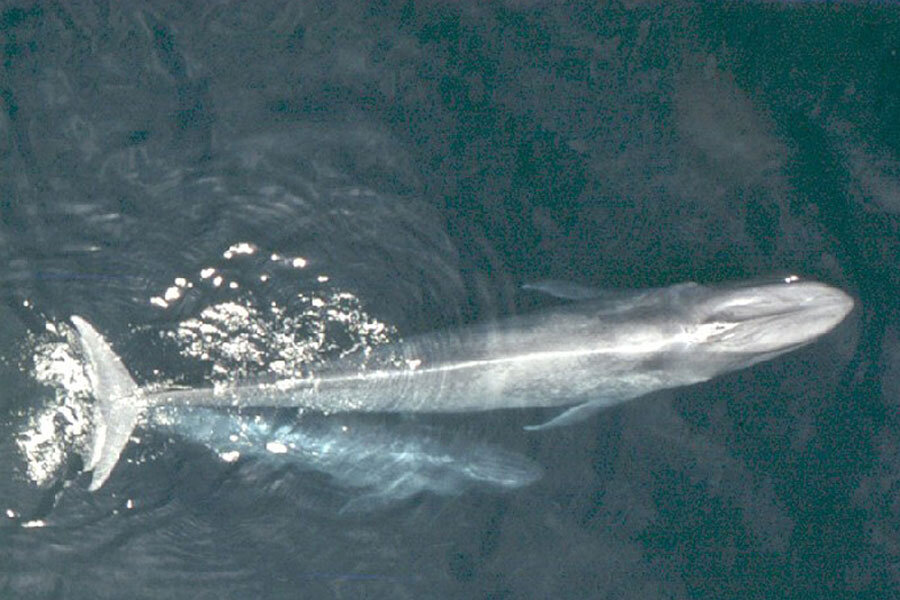Whaling ban seen as restoring blue whales in northeast Pacific
Loading...
The number of blue whales in the northeastern Pacific appears to have returned to near-historic levels thanks to a 48-year international ban on commercial or subsistence whaling for this species and allied laws enacted at national levels.
The current population of blue whales off the US West Coast is about 2,200, or 97 percent of their levels at the beginning of the 20th century, according to a study published Friday in the journal Marine Mammal Science.
If the estimate holds up to additional scrutiny, it represents encouraging news given increased concerns about the impact of ship strikes on the whales, which can grow nearly 110 feet long and tip the scales at 165 tons – the largest animals on the planet.
The scientists conducting the study consider the current population of blue whales in the region to be robust enough to withstand the current losses from ship strikes. They estimate that the number of ships plying West Coast waters could increase 11-fold over current levels before the region's blue-whale population faced a 50 percent chance of dropping below the "depleted" level, as defined by the US Marine Mammal Protection Act.
Even so, "we don't want these whales killed by ships," insisted Trevor Branch, a marine scientist at the University of Washington at Seattle who was a member of the research team, in a prepared statement.
These leviathans have long been icons for wildlife conservation in general and marine conservation specifically. Recent studies suggest they also play an under-appreciated role as a source of near-surface nutrients for organisms at the bottom of the food chain in the regions they inhabit.
Often seen as a competitor with other species for krill as food, the whales indirectly support them through their iron-rich feces, according to a study published in July in the journal Marine Mammal Science. This iron supports the growth of plankton on which the krill feed in waters that are iron-poor, such as the southern ocean.
The study, conducted by a team led by Trish Lavery and Ben Roudnew at Flinders University in Adelaide, Australia, notes that when this natural iron-fertilization is included, the ecosystem model used to demonstrate that blue whales out-compete other species for krill shows a dramatic shift. Assuming that blue-whale population in the southern ocean stood at historical levels, this fertilization – some 3,300 tons of iron per year – would take nothing from other species and lead to a stable krill population for the whales.
Indeed the long-term decline in plankton and krill there, which has been attributed to climate change, may in fact have been driven largely by whaling's impact on the number of filter-feeding, or baleen, whales and the fertilization they provide, the researchers suggest.
The team producing the recovery estimate for blue whales in the northeastern Pacific based their tally on previous research they conducted – the first study to analyze past catch reports and separate them into northeastern and northwestern Pacific populations.
To do that, the team, led by University of Washington PhD candidate Cole Monnahan, used whale calls unique to each broad group to trace the paths and timing of their migrations, then applied the results to the most recent updates to historical catch reports. They estimated that between 1905 and 1971, whalers took 6,362 blue whales from the northwestern population and 3,411 from the northeastern group. The team published those results in the journal PLoS One in June.
By deriving an annual average catch during that period and combining it in a population model, Mr. Monnahan and colleagues found that today's northeastern Pacific population represents 97 percent of their estimate for pre-1905 levels.
The study demonstrates “the ability of blue whale populations to rebuild under careful management," the team notes.
The northeastern Pacific subgroup probably was a small one to start with, researchers say. During the same 66-year period, some 346,000 blue whales were killed in the southern ocean. The International Whaling Commission has estimated that prior to commercial whaling, the population of blue whales in the Southern Hemisphere numbered around 175,000 and is now down to about 2,000.
Globally, the IWC estimates that the population of blue whales has declined from about 180,000 before modern commercial whaling to about 5,000 today.
Other researchers have noted that population growth among the northwestern blue whales has slowed. Many have looked at ship strikes, averaging about 11 a year, as a possible cause.
But if the population indeed has reached 97 percent of its historic levels, the decline in population growth may merely reflect an emerging balance between the number of whales and the number their range can sustain, Monnahan and colleagues suggest.
Even so, ship strikes remain a concern. In an effort to map the comings and goings of blue whales off the West Coast, a team led by Ladd Irvine, a senior faculty research assistant at Oregon State University's Marine Mammal Institute in Newport, Ore., tagged 171 blue whales between 1993 and 2008 to track their movements through the US's 200-mile limit.
The team found whale activity all along the US West Coast within this limit, but the results also showed two hot spots: one off of San Francisco and the Farallon Islands and the other around the Channel Islands off Santa Barbara. An additional, a luke-warm spot for whale activity appears off of Cape Mendocino. In all three places, cold nutrient-rich water wells up to support krill for hungry whales.
The team used the results, published in July in PLoS One, to suggest new or modified shipping lanes that would reduce the risk of strikes, particularly during the prime feeding seasons.








